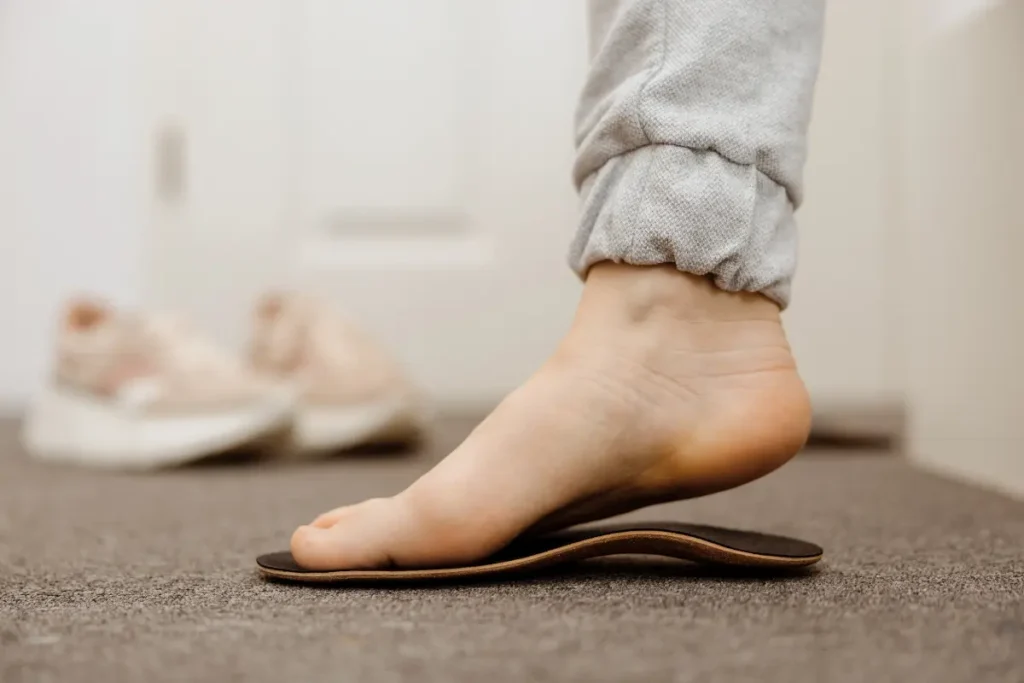This guide is for informational purposes only. Some services may not be offered in our offices. Your doctor will guide you through your treatment options during your appointment.
As a parent, ensuring your child’s overall health and well-being encompasses various factors, and one often overlooked aspect is their foot health. Children’s feet undergo significant changes throughout their early years, making proper care essential for their growth, mobility, and long-term comfort.
This comprehensive guide delves into the importance of children’s foot health, highlighting common foot problems and their prevention and treatment. We will explore the critical role that healthy feet play in a child’s development, discuss signs to watch for that may indicate foot issues, and provide actionable steps to promote good foot hygiene and proper footwear. By understanding these aspects, you can help ensure your child enjoys a lifetime of healthy, active living.
Building a Strong Foundation
A child’s feet develop rapidly, transitioning from soft cartilage at birth to bones by the age of three. During early childhood, the feet double in size and by the age of twelve, they reach 90% of their adult size. These developmental years are critical in ensuring proper foot structure and function, making foot care essential.
Early Detection of Foot Abnormalities
Identifying foot problems during early childhood is crucial. Conditions like flat feet, in-toeing, and out-toeing can be corrected if spotted in time, minimizing the risk of complications later in life.
Impact on Balance and Mobility
Healthy feet are vital for a child’s balance and mobility. Foot problems can limit their ability to walk, run, and engage in physical activities, potentially affecting their participation in sports or play.
The Ripple Effect on Posture and Overall Health
Foot health issues can impact the body’s posture, leading to knee, hip, or even back pain. For instance, flat feet can cause misalignment, creating discomfort throughout the body. Proper foot care can prevent these broader health issues from developing.
Flat Feet
Flat feet occur when the foot’s arch does not develop properly. This is common in toddlers but may persist beyond the age of five. Signs include foot pain, an unusual walking pattern, and difficulty wearing shoes. If the condition continues, professional evaluation is necessary.
In-toeing and Out-toeing
In-toeing (feet turning inward) and out-toeing (feet turning outward) often become noticeable when a child starts walking. These conditions usually resolve with growth but may require medical attention if they cause tripping or persist into later childhood.
Plantar Warts
Plantar warts are viral growths that develop on the soles of the feet, often causing discomfort while walking or standing. Although these warts can disappear on their own, professional treatment may be necessary if they persist or spread.
Ingrown Toenails
Ingrown toenails occur when the edge of the toenail grows into the surrounding skin, causing pain, swelling, and redness. This condition can result from improper nail trimming or ill-fitting shoes and may require minor medical intervention.
Sever’s Disease
Sever’s disease is a common cause of heel pain in active children, particularly those engaged in sports. It results from inflammation in the heel’s growth plate. Treatment typically includes rest, heel pads, and stretching exercises, with symptoms resolving once the child’s growth is complete.

Signs to Watch For
Detecting foot issues early can prevent long-term complications. Warning signs include frequent tripping, avoidance of physical activity, complaints of foot pain, and unusual walking patterns such as persistent in-toeing or flat feet. If these symptoms appear, it’s essential to consult a podiatrist.
The Importance of Proper Footwear
Shoes play a critical role in a child’s foot health. Ill-fitting shoes, whether too tight or too loose, can lead to foot problems. Ensure that your child’s shoes fit properly, with enough room for the toes to move freely and adequate arch support. Regularly replacing worn-out shoes helps maintain healthy foot development.
Promoting Physical Activity
Encouraging regular exercise strengthens your child’s foot muscles and improves flexibility. Activities like barefoot exercises and games that engage the toes can enhance foot strength and coordination, benefiting overall physical development.
Hygiene Practices
Maintaining proper foot hygiene is vital to preventing infections like athlete’s foot and fungal nail conditions. Teach your child to wash their feet daily, dry them thoroughly, and wear clean socks. Regularly alternating shoes to allow them to dry also reduces the risk of fungal growth.
Physical Therapy and Custom Orthotics
Physical therapy can be an effective treatment for various foot issues, helping to improve muscle strength, balance, and posture. Custom orthotics, or shoe inserts, can provide additional support for conditions like flat feet, promoting proper alignment.
Medications and Topical Treatments
Topical treatments, such as antifungal creams for athlete’s foot or salicylic acid for plantar warts, can resolve many common foot conditions. More severe issues might require oral medications or further medical interventions.
Surgical Solutions
While surgery is rare in children, some severe conditions may warrant it. For instance, recurring ingrown toenails or persistent flat feet causing discomfort might require minor surgical procedures to correct the problem and restore normal foot function.
When to Seek Professional Help
If foot problems persist or cause significant pain, it’s crucial to consult with a podiatrist. Professionals at Modern Foot & Ankle can provide tailored treatments to ensure your child’s feet are developing correctly, helping them maintain active, healthy lives.
The information on our website is intended for general informational and educational purposes only and should not be used as a substitute for professional medical advice. For any health-related concerns, we strongly recommend consulting with a healthcare professional. Please note that any reliance on the information found on our site is solely at your own risk. For more details, please see our Medical Disclaimer.
Modern Foot & Ankle offers expert foot and ankle care, conveniently located in your Florida or Texas community. Our multiple locations offer a wide network of the best podiatrists, skillfully trained to meet your specific needs. Our nationally recognized physicians and surgeons cover the full spectrum of foot and ankle concerns, including complex lower extremity conditions. Our foot and ankle doctors combine advanced technology with patient-centric care to deliver treatment plans to get you back on your feet, often right inside your neighborhood.
Browse our extensive network of offices across Florida and Texas, and experience the best foot and ankle care at your nearest local Modern Foot & Ankle location.
Stay informed by reviewing some of our patients frequently asked questions about what to expect when visiting one of our Florida or Texas foot and ankle care offices. Contact the office directly if you need further assistance. We’re here to help!
Modern Foot & Ankle offers a wide range of podiatry services including foot and ankle surgery, sports medicine, pediatric foot care, wound care, orthotics, and more. They also provide specialized treatments for conditions such as bunions, hammertoes, heel pain, and ingrown toenails among others.
To schedule an appointment, you can call the clinic directly or fill out the appointment request form available on their website. They have multiple locations, so you can choose the one that’s most convenient for you.
During your first visit, the podiatrist will conduct a thorough examination, discuss your medical history, and address any concerns or symptoms you may have. They will then develop a personalized treatment plan based on your specific needs.
Yes, the podiatrists at Modern Foot & Ankle are skilled in performing a variety of foot and ankle surgeries. These include procedures for bunions, hammertoes, fractures, and more. They utilize the latest techniques and technology to ensure the best possible outcomes for their patients.
Modern Foot & Ankle is committed to providing comprehensive, high-quality podiatric care. They believe in a patient-centered approach, where the focus is on educating patients about their condition and treatment options, enabling them to make informed decisions about their care.
Modern Foot & Ankle accepts a variety of insurance plans. It’s recommended to check with the clinic directly or with your insurance provider to confirm coverage before scheduling an appointment.

